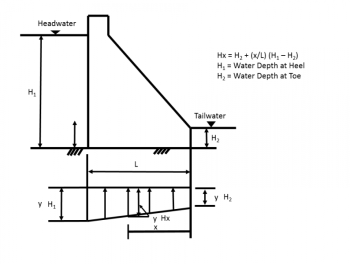Global Stability of a Dam: Difference between revisions
No edit summary |
No edit summary |
||
| Line 6: | Line 6: | ||
| [[Image:GravityDamUplift1.png|350px|x350px|link=https://damfailures.org/lessons-learned/concrete-gravity-dams-should-be-evaluated-to-accommodate-full-uplift/]] | | [[Image:GravityDamUplift1.png|350px|x350px|link=https://damfailures.org/lessons-learned/concrete-gravity-dams-should-be-evaluated-to-accommodate-full-uplift/]] | ||
|- | |- | ||
|style="text-align:center; font-size:90%;"| Learn more | |style="text-align:center; font-size:90%;"| Learn more about the need to consider uplift pressure when designing a gravity structure at [https://damfailures.org/lessons-learned/concrete-gravity-dams-should-be-evaluated-to-accommodate-full-uplift/ DamFailures.org] | ||
|} | |} | ||
<!-- Introductory paragraph or topic page summary --> | <!-- Introductory paragraph or topic page summary --> | ||
When a dam impounds a body of water, it will experience a load or force commonly referred to as hydrostatic pressure. A variety of other forces such as uplift pressure, earth pressure, silt pressure, wave pressure, wind pressure, ice pressure, [[seismic]] acceleration, hydrodynamic pressure, and thermal stress from ambient temperature changes can also act on the dam depending upon site conditions. Global [[stability]] refers to the ability of the dam to withstand all design loading conditions with adequate safety margin. This is a function of the geometry and material properties of the dam as well as the magnitude and combination of loads acting on the structure. | |||
==Required Data== | ==Required Data== | ||
Revision as of 16:52, 14 December 2022

|
| Learn more about the need to consider uplift pressure when designing a gravity structure at DamFailures.org |
When a dam impounds a body of water, it will experience a load or force commonly referred to as hydrostatic pressure. A variety of other forces such as uplift pressure, earth pressure, silt pressure, wave pressure, wind pressure, ice pressure, seismic acceleration, hydrodynamic pressure, and thermal stress from ambient temperature changes can also act on the dam depending upon site conditions. Global stability refers to the ability of the dam to withstand all design loading conditions with adequate safety margin. This is a function of the geometry and material properties of the dam as well as the magnitude and combination of loads acting on the structure.
Required Data
Evaluation Criteria
Types of Analyses
Examples
![]() Learn more about the need to consider uplift pressure (DamFailures.org)
Learn more about the need to consider uplift pressure (DamFailures.org)
![]() Learn from the critical oversights that led to the failure of St. Francis Dam (DamFailures.org)
Learn from the critical oversights that led to the failure of St. Francis Dam (DamFailures.org)
Best Practices Resources
![]() Design Standards No. 13: Embankment Dams (Ch. 6 Bulkhead Gates and Stoplogs), USBR, 2018
Design Standards No. 13: Embankment Dams (Ch. 6 Bulkhead Gates and Stoplogs), USBR, 2018
![]() Strength Design for Reinforced Concrete Hydraulic Structures (EM 1110-2-2104), USACE, 2016
Strength Design for Reinforced Concrete Hydraulic Structures (EM 1110-2-2104), USACE, 2016
![]() Design Standards No. 13: Embankment Dams (Ch. 13: Seismic Analysis and Design), USBR, 2015
Design Standards No. 13: Embankment Dams (Ch. 13: Seismic Analysis and Design), USBR, 2015
![]() Design of Hydraulic Steel Structures (ETL 1110-2-584), USACE, 2014
Design of Hydraulic Steel Structures (ETL 1110-2-584), USACE, 2014
![]() Design Standards No. 13: Embankment Dams (Ch. 9 Static Deformation Analysis), USBR, 2011
Design Standards No. 13: Embankment Dams (Ch. 9 Static Deformation Analysis), USBR, 2011
![]() Design Standards No. 13: Embankment Dams (Ch. 4 Static Stability Analysis), USBR, 2011
Design Standards No. 13: Embankment Dams (Ch. 4 Static Stability Analysis), USBR, 2011
![]() Calculating Forces on Components of Hydraulic Structures (ERDC/CHL CHETN-IX-21), USACE, 2009
Calculating Forces on Components of Hydraulic Structures (ERDC/CHL CHETN-IX-21), USACE, 2009
![]() Earthquake Design and Evaluation of Concrete Hydraulic Structures (EM 1110-2-6053), USACE, 2007
Earthquake Design and Evaluation of Concrete Hydraulic Structures (EM 1110-2-6053), USACE, 2007
![]() Stability Analysis of Concrete Structures (EM 1110-2-2100), USACE, 2005
Stability Analysis of Concrete Structures (EM 1110-2-2100), USACE, 2005
![]() Roller-Compacted Concrete (EM 1110-2-2006), USACE, 2000
Roller-Compacted Concrete (EM 1110-2-2006), USACE, 2000
![]() Gravity Dam Design (EM 1110-2-2200), USACE, 1995
Gravity Dam Design (EM 1110-2-2200), USACE, 1995
![]() Arch Dam Design (EM 1110-2-2201), USACE, 1994
Arch Dam Design (EM 1110-2-2201), USACE, 1994
![]() Lock Gates and Operating Equipment (EM 1110-2-2703), USACE, 1994
Lock Gates and Operating Equipment (EM 1110-2-2703), USACE, 1994
![]() Design of Small Dams, USBR, 1987
Design of Small Dams, USBR, 1987
Trainings
![]() On-Demand Webinar: Rehabilitation of Concrete Dams
On-Demand Webinar: Rehabilitation of Concrete Dams
![]() On-Demand Webinar: Stability Evaluations of Concrete Dams
On-Demand Webinar: Stability Evaluations of Concrete Dams
![]() On-Demand Webinar: Analysis of Concrete Arch Dams
On-Demand Webinar: Analysis of Concrete Arch Dams
![]() On-Demand Webinar: Introduction to Concrete Gravity Dams
On-Demand Webinar: Introduction to Concrete Gravity Dams
Citations:
Revision ID: 5669
Revision Date: 12/14/2022
